Pitbulls are one of the most popular dog breeds in the world. In America alone, there are 4.5 million Pitbull mixes. As a percentage, it’s 6% of the American dog population. In every case, Pitbulls score more than 85% on temperament tests, and that’s a pretty good score for a dog breed.
Not only that, in World War I, a Pitbull named Stubby has earned 13 decorations and the rank of a sergeant. These facts show that Pitbulls are a very trainable dog breed.
But there is much backlash for this dog breed because of these reasons. Studies show that between 2005 to 2019, there were 30 – 40 fatal dog bites per year, and most of them were caused by a Pitbull. Statistics show that you are 215% more likely to get a fatal attack from a Pitbull dog than another dog breed.
Also, in 2019, 39 dog bite-related deaths by Pitbulls were reported. 20 states have confirmed that Pitbulls were involved in most bite incidents between 2013 and 2021.
But studies have also shown that in 94% of attacks involving Pitbulls, the dog is either male or not neutered. So it suggests that neutering a male Pitbull would exponentially decrease the dog’s aggressiveness.
Despite all of that, any dog can be aggressive under specific circumstances. So, my opinion is that if you treat your Pitbull right and with love and care, they will grow up to be a very loving and perfect doggo. Just look how cute Pitbull puppies are.
So, these are the things you need to know about Pitbull Puppy.
Table of Contents
Types of Pitbull Dogs
Usually, Pitbull type dogs are very muscular than other breeds. They would have similar large square heads. They are heavy build and have deep chests. These dogs won’t give up easily when doing something. They are very determined and crave attention. These doggos usually love people, even strangers. But it’s very important that you train and socialize your Pitbull dog from a very young age. Otherwise, it will be hard to handle them when they grow up. Without proper training, Pitbulls would jump to people to greet them, and it will be hard to pull them back with their strong build.
- American Pitbull Terrier

Weight: 30 to 65 lbs.
Height: 17 to 20 inches
Physicality: Short coat with a muscular build. Coat color contains black, white, red, blue, gray, tan, fawn, and brindle.
This dog breed is not recognized by the American Kennel Club but by the United Kennel Club. This dog breed has become famous in North America around the late 19th century. But sadly, American Pitbull Terriers are primarily used for dogfighting. This breed is well known for building a powerful bond with their family even though they don’t get along with other dogs. Like most Pitbull breeds, they are prone to be loyal and affectionate.
- American Staffordshire Terrier

Weight: 50 to 80 lbs.
Height: 17 to 19 inches
Physicality: Short coat. Coat color contains blue, fawn, red, brown, black, brindle pattenrs, and sometimes white.
This breed’s history runs back to 19th century England. As a result of its development in the late 19th century North America, this larger Pitbull breed has come to life. Luckily, American Staffordshire Terriers are not commonly used in dog fighting, unlike other Pitbull breeds. This breed is also playful and very loyal towards the family however, they don’t get along with other dogs.
- American Bully
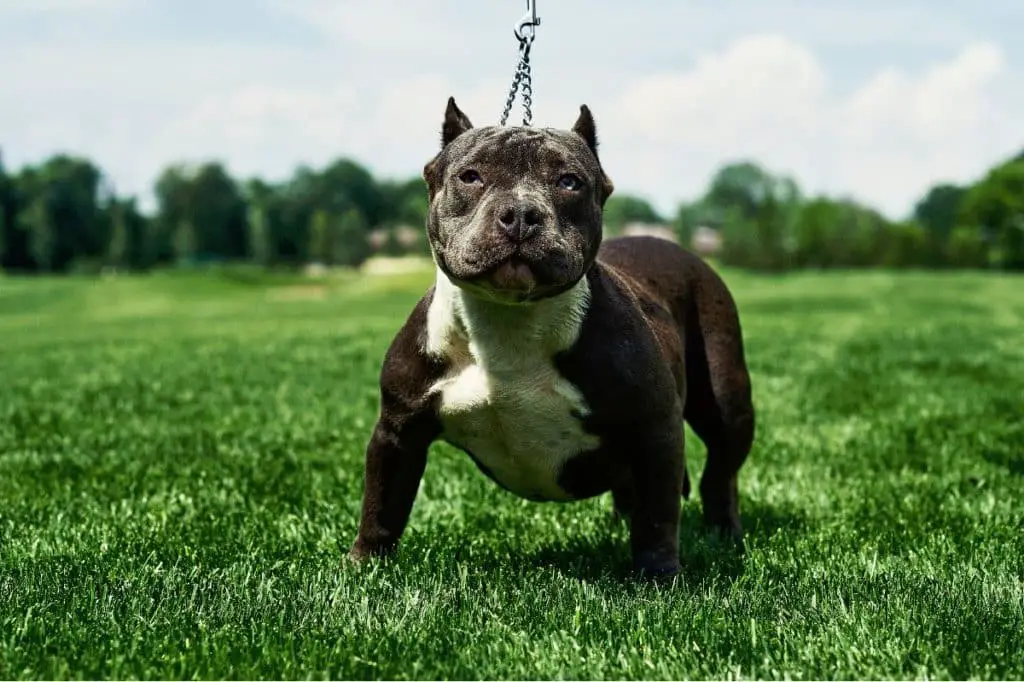
Weight: 65 to 85 pounds
Height: 13 to 20 inches
Physicality: Strong and muscular. Thickset and compact. It has a short and smooth coat that comes with a wide variety of colors and patterns.
This is a new breed that was developed in the late 80s. They were recognized by the United Kennel Club in 2013 but not yet by the American Kennel Club. American Bulldog is a descendant of American Pitbull terrier and other bulldog-type breeds. American Bully has a wider head and a stronger build than most dogs. Despite that, responsible breeders have developed American Bullies precisely because of their affectionate and gentle behaviors. But keep in mind that since they are powerful and athletic, they require much exercises to be healthy and happy.
- American Bulldog
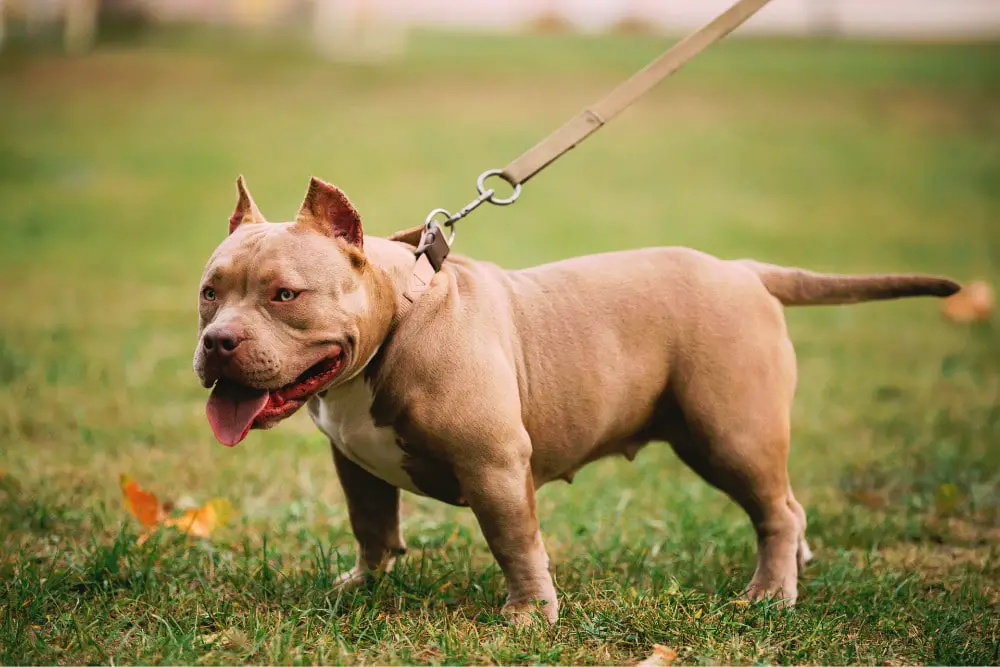
Weight: 60 to 120 pounds
Height: 20 to 28 inches
Physicality: Deep chest, short muzzle, and Stocky build. Usually white with patches of black, red bridle, or shades of gray or brown.
This breed is a descendant of English bulldogs. This breed was developed in the 17th century for bull baiting. It’s a cruel blood sport where raging bulls are put to fight against other animals, typically dogs. Luckily, it’s not a sport now, and it’s illegal. This breed became working dogs in North America since they make great friendly companions. American Bulldogs are prone to become very affectionate toward their family members. This breed is also famous for sitting on laps even though they are huge in size. This breed also often loves to play with little kids. But keep in mind that American Bulldogs can become overprotective of their families, so they might attack others if they feel like they or their family is being threatened. So, you have to ensure that you properly socialize and train your American Bulldog from a younger age.
- Staffordshire Bull Terrier
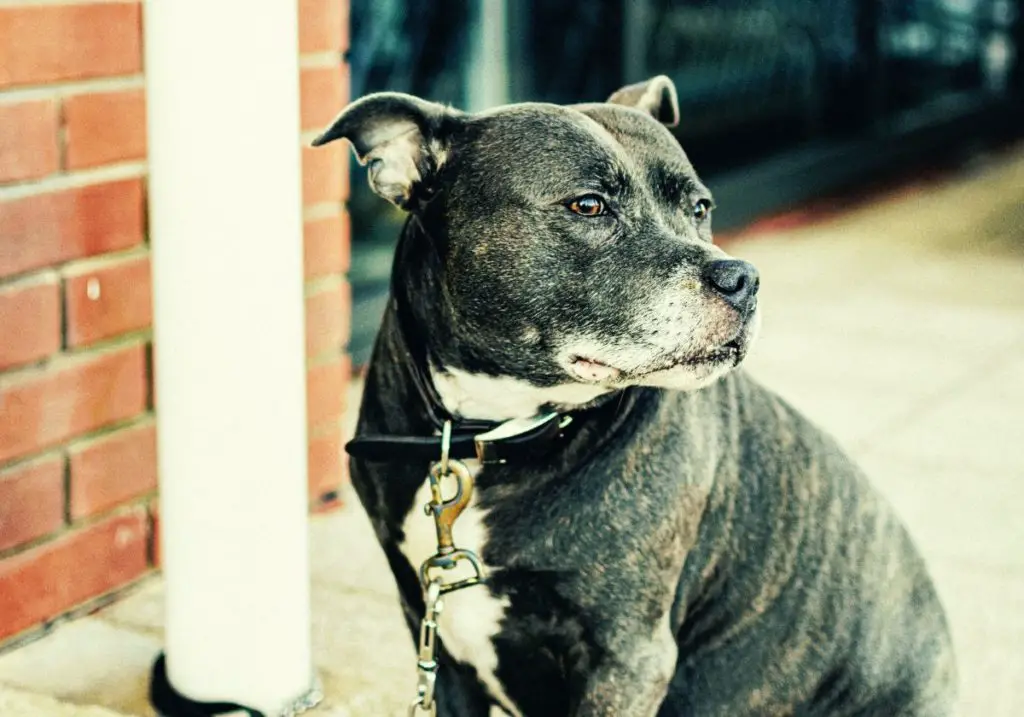
Weight: 24 to 38 pounds
Height: 14 to 16 inches
Physicality: Muscular build with a short and shiny coat. Coat color contains Black, Fawn, white, blue, and brindle.
This breed was developed in the 19th century for dog fights specifically. Despite that, Staffordshire Bull Terriers are famous for being loyal and affectionate toward their family members. Their favorite thing to do is to snuggle and play with family members. This breed is also very gentle and patient with children. Staffordshire Bull Terriers are very suitable for households with family members because they are vulnerable to separation anxiety. Like other Pitbull breeds, this breed also doesn’t get along with other dogs.
Regarding Pitbull doggos, it’s imperative to train them from a young them. Studies have shown that most Pitbull related injuries have occurred due to poor training.
How to Train Your Pitbull Puppy?
There are a couple of things you need to follow when training any doggo. The first and most important thing is consistency. If you are going to start a training program for your Pitbull puppy, you must be consistent. Otherwise, the pup will be confused, which can undermine your authority over your pup. Also, being firm when maintaining rules and boundaries is essential. If not, that will also decrease your dominance in the relationship. Being dominant over your pup is really important because otherwise, your pup won’t obey your orders.
Also, it’s crucial that you don’t punish your pup. Studies have shown that positive reinforcement is the key to a well-trained dog. Also, positive reinforcement will help you form a healthy bond between you and your doggo. Timing is also important because the younger the Pitbull pup, the better you can train it.
Training at 3-8 Weeks
This is the first stage of training. At this stage, you can teach the below commands to them. These will become lifelong habits to them after you train them this.
- Listen and Watch
This command will make your pup stop whatever they are doing and pay attention. You can show them a treat and hold it in front of your face. Say “Watch” or “Look” while doing it. The command should be a short but firm one, so it would be easy for the pup to understand it.
When your pup stops and pays attention to you, give the treat and praise them. Like mentioned above, positive reinforcement is the name of the game. Once the pup gets used to the command, slowly increase the amount of time you hold the treat in front of your face so your pup will pay more and more attention to you.
- Sit
This is a very basic and easy to teach command. Get a good treat and hold it above your Pit pup’s head. While they are looking at the treat, slowly move it over their head and a few inches behind them so the pup will have to back up. Since the pup is so focused on the treat, this will make them eventually sit down. When their butt hits the floor, say “sit” firmly and give them the treat and praise them. By doing this for some time, your pup will follow your command even without a treat.
- Lay Down
After your Pit pup is familiar with the “Sit” command, teach them the “lay down” command.
Hold the treat to your pup’s eye level and slowly bring it down to the floor. Don’t let them eat the treat until they lay down. When your pup’s belly hits the floor, say “lay down” and give the treat and praise them. When you continue to do this, your pup will understand this command and follow it even without a treat.
- Name Calling
This is where the pup gets familiar with their given name. But remember that you have to decide on a name quickly. In this case, it’s sooner, the better. After you decide on a name for your Pit pup, always call your pup by their name so the pup will get used to it.
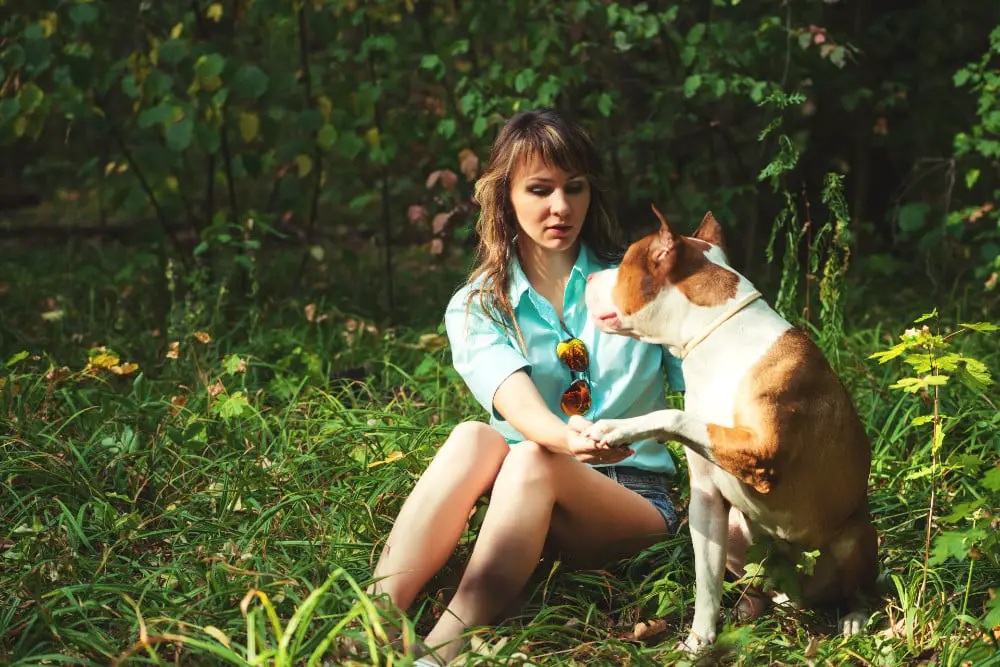
Training at 8-12 Weeks
At this age, your Pit pup can learn more focused base commands. The pup’s attention span and memory will start to increase at this age. Since your pup already knows some basic commands, this stage is the perfect time to teach them “potty training” and “summoning them when called.”
- Come
This is one of the most important commands for any dog. In a life-threatening situation, this command could even save your dog’s life. So your Pitbull should stop whatever they are doing and come to your when you command.
The best place to teach this command is at home. For this, please get a helping hand. Both you and your friend can get a handful of treats and command your Pit pup to “come.” You can clap or whistle to get their attention the first few times. When your pup comes to you, give it a treat. Then your friend will command your pup to come. When it goes to your friend, your friend will give a treat. This will let the pup know that it’s the command that needs to follow.
You can do this while hiding even. So it would be like hide and seek.
- Stay
While your Pit pup is sitting or lying down, stand up and step back a little, and say “stay.” If your pup doesn’t move, give a little treat and praise them. Do this often while moving back a little more every time. Also, the longer the pup stays still, the better. So reward the pup every time it follows the command.
- Socialize
This age is the perfect age to start socializing your Pitbull puppy. As mentioned above, socializing with other dogs and people is a key factor in reducing their aggressiveness. Positive socializing is a great way to make your Pitbull pup into a loving and affectionate Pitbull doggo. Keep in mind that it’s your responsibility to monitor and supervise your Pitbull in these situations.
- Potty Training
This is a training step that no one would overlook since it’s that important. Make sure that your pup goes outside often when they are young.
When potty training, don’t ever punish your pup because they don’t know why they are being punished. Instead, every time they poop or pee outside, praise them and reward them. Make sure to do this right away after they have done with pooping or peeing so the pup will understand that it’s the right thing to do. Do this every time when they do their business outside, and your Pit pup will be a well potty trained pup.
Make sure that you give attention when your pup has to go out. Otherwise, they will do their business inside if they can’t hold it in.
If you like to learn about how to potty train you can read this article on How to Potty Train a German Shepherd Puppy.
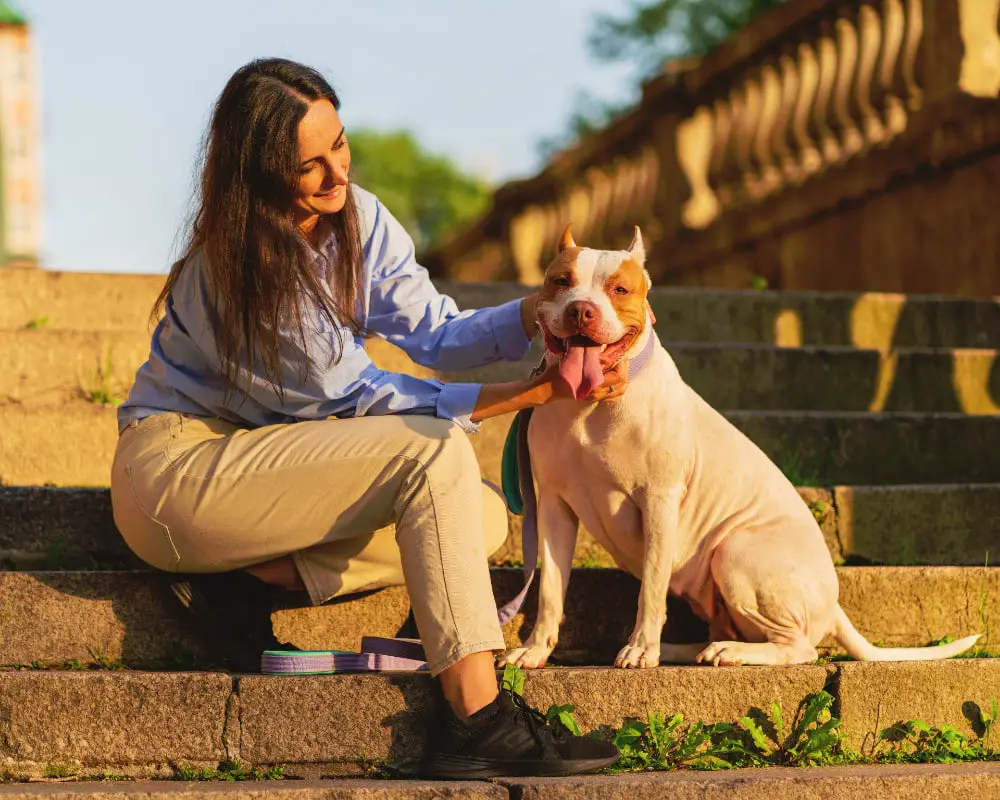
Training 12-16 Weeks
This is the stage where you should let your Pit pup blow off some steam. You can do these tricks for that.
- Fetch
Introduce your pup to a toy like a tennis ball. Show it and give them a little treat. And then, toss it (not too far) and observe if your pup would bring it.
If your pup picks it up, praise them and give another treat. The next part is a bit tricky. This time, after your pup picks it up, encourage them to bring it to you. You can call the pup by their name or clap them or show them the treat.
Reward them the moment they bring back the toy. After that, throw the toy far and far away.
- Jump
Make your pup sit and hold a treat over their head and say “jump.” You can even jump yourself to demonstrate it. If your Pit pup doesn’t understand it, bring the treat a bit closer to their face, and when they try to take the treat, hold it back.
When they jump, say “jump” firmly and give the reward. Do this often so they will get familiar with this command. After your pup gets very familiar with this command, you can even try it while the pup is running.
- Leash Walking
A Pitbull should always have the ability to walk on a leash without pulling. This means that they follow your speed, and you control the dog. If it pushes the leash, that means your dog is walking you.
So while walking on a leash, if your Pit pup gets ahead, stop and pull the leash. If it goes with your speed side by side, offer a little treat and praise your pup. Do this consistently, and your pup will always follow you at your speed.

Pitbull Myths & Facts
There is a famous and common myth about Pitbulls that they have a high tolerance for pain. The truth is that all dogs feel pain, including Pitbulls.
- Myth – Pitbulls have a stronger bite than other dog breeds
Statistics show that this is a myth. American Bulldogs is on the fourth on the list of strongest bite. American Pitbull has a very lower spot on that list. On the other hand, Rottweiler has a much stronger bite, and Kangals holds the number one spot on the list with a 743 PSI bite
- Fact- Pitbulls don’t have a locking jaw
People think that Pitbulls have a locking Jaw, and that’s one of the reasons for their negative misconception. Pitbulls don’t have a unique locking mechanism, but they tend to bite with such enthusiasm.
You can learn more about myths about Pitbulls from this link.
Pitbulls Face Unfair Discrimination
A lot of people don’t like the Pitbull breed because of their aggressiveness. But studies have shown that these dogs behave like that because they are not being loved and trained properly. If you show affection toward your Pitbull Doggo, they will grow up to be a loving family dog.
But still, many Pitbulls die in animal shelters in America alone. Studies show that 15% – 20% of dogs in shelters are Pitbull breeds. 40% of Pitbulls in shelters are euthanized each year because the adoption rate for Pitbulls is remarkably low. Also, because of public opinion about Pitbulls, it takes three times longer for a Pitbull to get adopted than other breeds. Researches show that more than 25% of Americans view Pitbulls as bad dogs. Not only that, more than half of Americans (50%) strongly believe that a family with small children should never adopt this dog breed. This is why a lot of Pitbulls remain in dog shelters.
A study also had shown that 75% of shelters get the dog labels wrong, and 64% of Pitbulls got adopted when a shelter removed their Pitbull labels. This is because they are often mislabeled.
You can learn about the Position Statement on Pitbulls from this link.
Pitbulls gets Abused more often
If we look at the history of Pitbulls, they were originally bred for dog fighting and bull baiting. Because of this, Pitbulls tend to attack other animals than other dog breeds. But this won’t be an issue if you train and socialize your Pitbull properly. But reports show that people still use Pitbulls for dog fights a lot. This is animal abuse and animal cruelty. These dogs are not just forced to fight each other, they also have worse living conditions. To achieve the top level of aggression, these dogs are forced to live in hunger and dark without any socialization. This is why Pitbulls need and deserve so much love and affection.
You can learn more about the history of Pitbull dog fights from this link.
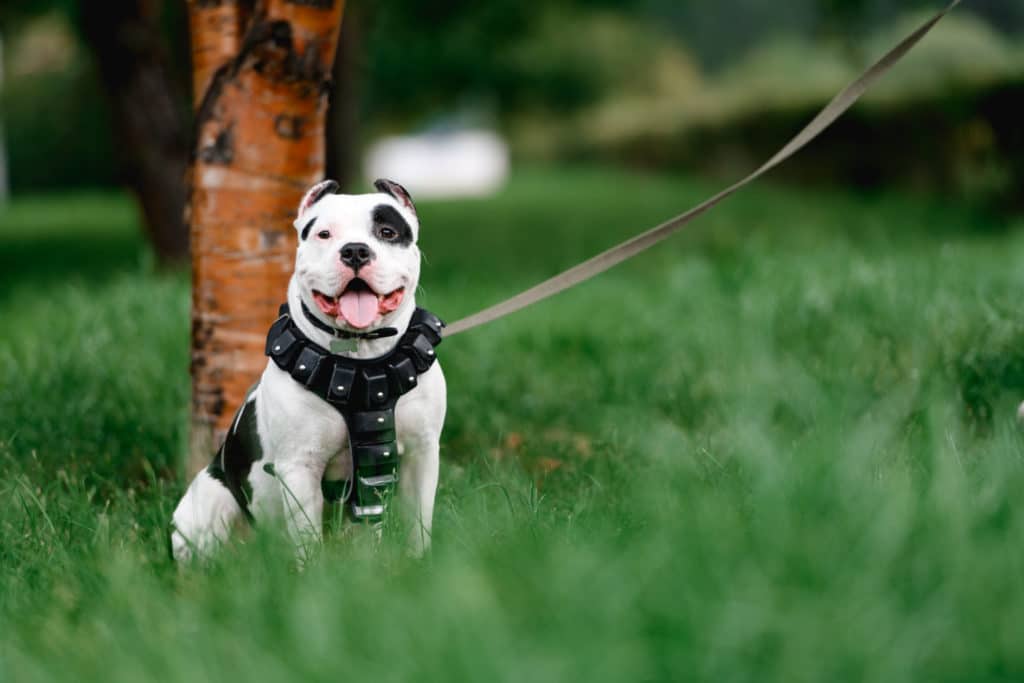


Pingback: A Simple Guide on How to Introduce a Puppy to a Dominant Dog - Grow Your Paw
Pingback: A Simple Guide on How to Introduce a Puppy to a Dominant Dog